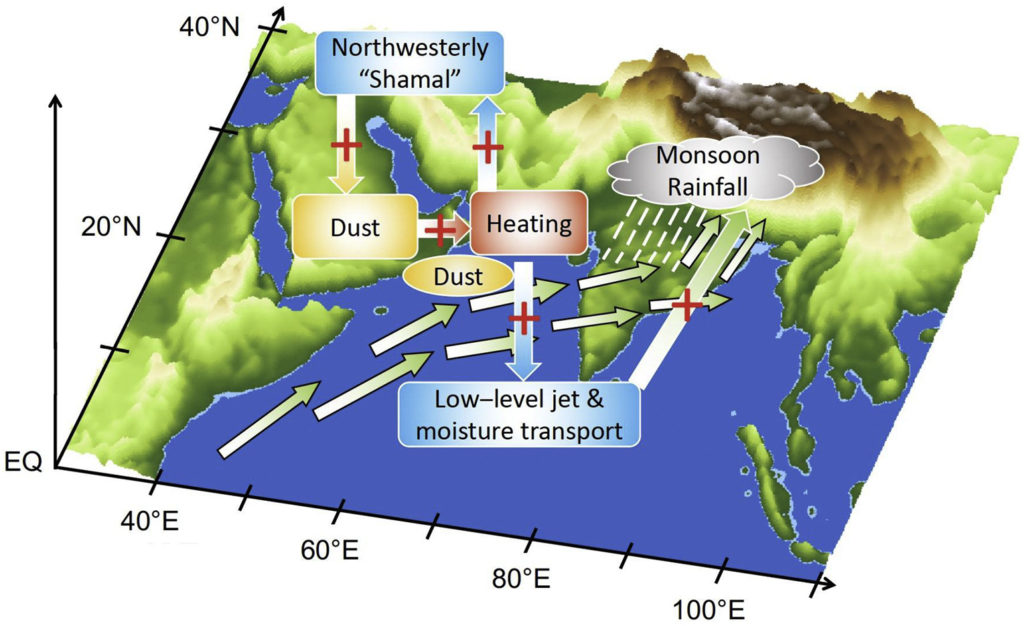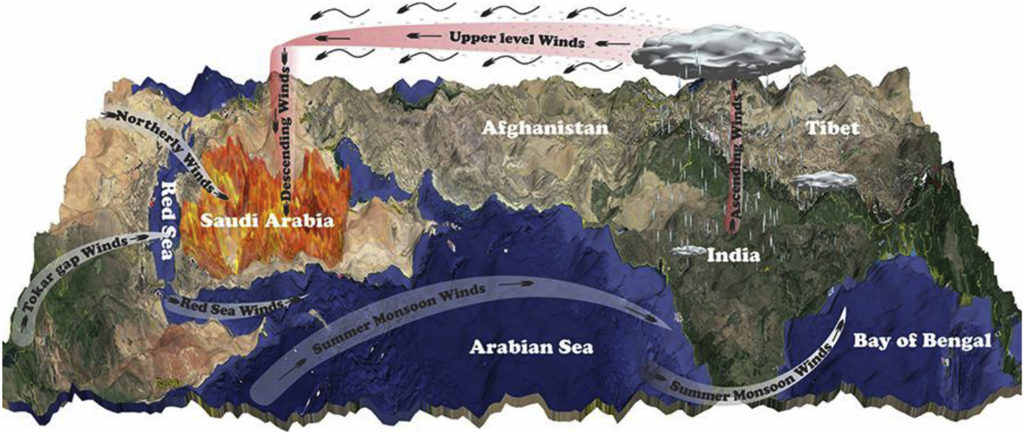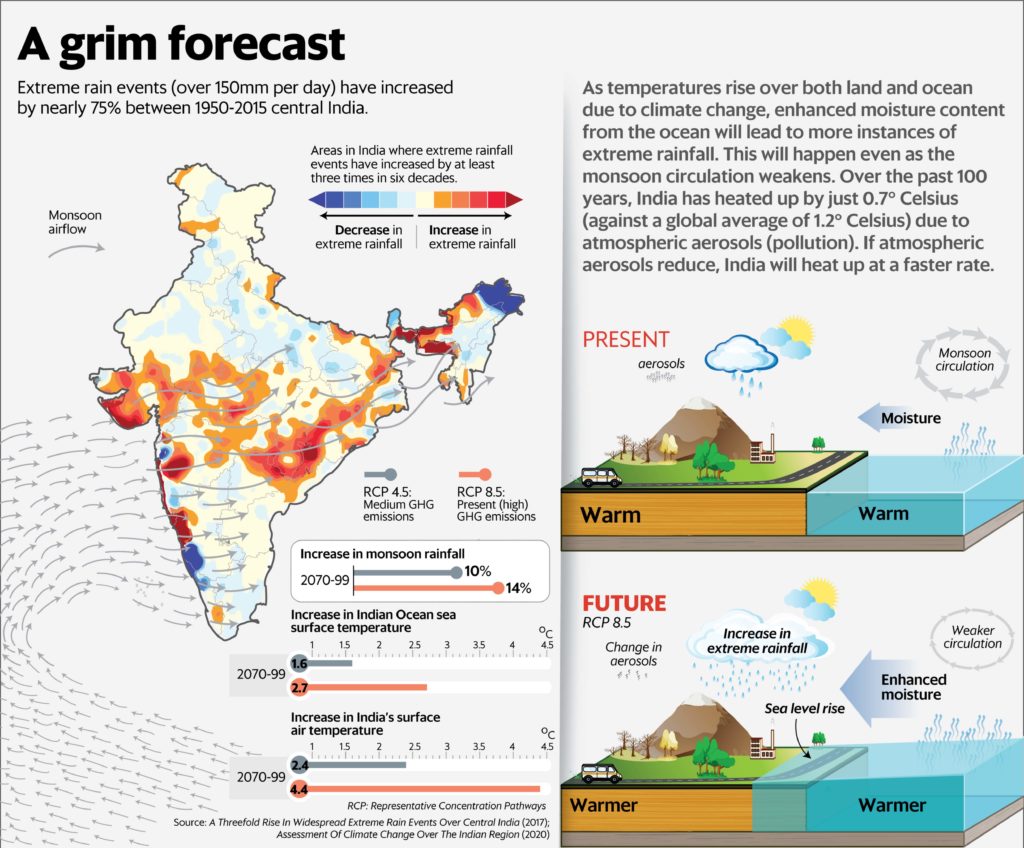ForumIAS announcing GS Foundation Program for UPSC CSE 2025-26 from 19 April. Click Here for more information.
Contents
| For 7PM Editorial Archives click HERE → |
Introduction
The South-west Monsoon is a dominant weather system in the South Asian region. It lasts from June to September and is responsible for 75-80% of India’s yearly rainfall. The monsoon is vital for Indian economy as the kharif crops are largely dependent on monsoon rainfall. In addition, monsoon rainfall is critical for water supply, groundwater replenishment and generation of hydroelectricity. However, climate change is having a profound impact on monsoon. The rainfall is becoming more erratic, extremely heavy rainfall events are becoming more frequent with long dry spells in between, along with large regional variations in rainfall. The impact of climate change on monsoon will have critical implications for the people of India.
What are the impacts of climate change on Monsoon?
Multiple studies have been undertaken to understand the impact of climate change on Monsoon rainfall.
Excess Rainfall
Researchers at Indian Institute of Tropical Meteorology (IITM) Pune, refer to effects of higher temperature on monsoon rains. For every 1oC rise in temperature, the atmosphere can hold 7% more moisture. Excess rainfall is also being caused by the rapid heating of the global ocean, which has absorbed 90% of the excess heat generated by man-made climate change in the past 50 years. Researchers from Germany’s Potsdam Institute for Climate Impact Research (PIK) found that every additional degree of warming is likely to increase monsoon rainfall by 5%.
There is a strong relationship of the monsoon with sea surface temperature (SST). SST effects the monsoon circulation. Climate change is weakening the land-sea temperature gradient (the thermal contrast), thus drying the monsoon circulation. At the same time, there is an increase in moisture in the air because of rise in SST. So even if the monsoon circulation is weak strong winds can bring in plenty of moisture from the Arabian Sea region which then falls over land in the form of extreme rainfall.
Excess and extreme rain events over central India have increased threefold between 1950-2015, despite a weakening in overall monsoon circulation.
Impact of Events in the Middle-east
According to a study published in the journal ‘Earth Science Reviews’, events in the Middle-east are also impacting Monsoons. The paper found that dust particles swept into the atmosphere from deserts in the Middle East grow extremely hot under sunlight. They change the air pressure over the Arabian Sea. This creates a kind of heat pump in the sky, which drives moisture from above the ocean to the Indian subcontinent, leading to a wetter monsoon season. This then strengthens winds and could whip up even more dust particles creating a positive feedback loop.
Source: Earth-Science Reviews/Science Direct
Inconsistent rainfall across time and space
Wide variation in rainfall across regions is becoming a routine. A research paper published in the journal ‘Earth Systems Dynamics’ noted that human-wrought climate change is making the Indian summer monsoon wetter and more erratic.
IMD divides India into 4 broad regions: the South Peninsula (Karnataka, Telangana, Andhra Pradesh, Tamil Nadu, Kerala and the island union territories), Central India (Gujarat, Maharashtra, Goa, Madhya Pradesh, Chhattisgarh and Odisha), East and Northeast India (Bihar, Jharkhand, West Bengal and all north eastern states), and Northwest India (Rajasthan, Haryana, Delhi, Chandigarh, Punjab, Jammu and Kashmir, Ladakh, Himachal Pradesh, Uttarakhand and Uttar Pradesh).
In 2021, All regions saw above-normal rainfall in June. In July 2021, 3 out of the 4 regions witnessed below normal rainfall. But the South Peninsula States and UTs saw rainfall 26% above normal (July 2021). All regions except the East and North-east recorded below normal rainfall in August. At a 24% deficit, 2021 saw the first August drought since 2009.
Similar pattern has existed in 2022 season so far with wide regional variations. 7 states have received deficient rainfall. Of them, the 3 are from the North East. Manipur recorded a deficit of 48%. Tripura and Mizoram recorded deficit of 23% and 20% respectively. Bihar has deficit of 30%.
In the Northwest, Delhi has deficit of 37% and UP of 35%.
The Central and South Peninsula regions witnessed excess rainfall. These include Tamil Nadu (58% excess), Telangana (46%), Karnataka (35%), Gujarat (31%) and Maharashtra (26%).
There were heavy floods in the in Northeast India, especially in Assam and Meghalaya in June 2022. The region then went through a dry phase in July and August. In July, Gujarat, Rajasthan and Maharashtra suffered floods. August brought flood-like conditions in Kerala, Karnataka and central Indian states Odisha and Madhya Pradesh.
A study published by scientists from IITM published in journal Nature found that the rising unpredictability of monsoon westerly winds from the Arabian Sea is ‘driving surges of moisture supply, leading to extreme rainfall episodes across the entire central subcontinent‘.
Source: IMD. Most regions in South and Central India have received excess rainfall (blue, 20-59% more than long term average). The deficit regions (red, 20-59% less than long term average) are in the Northwest, East and Northeast Regions.
A Climate Scientist who is also Secretary, Ministry of Earth Sciences remarked, “The number of rainy days (in a season) is decreasing. And the length of the dry spells is increasing. The number of rainy days may be small, but when it rains, it will rain very heavily“.
According to the climate change assessment for the Indian region (2020) released by the Ministry of Earth Sciences, the frequency of localised extreme single-day rain events exceeding 150 mm per day increased by about 75% between 1950 and 2015. The Indian Meteorological Department (IMD) has noted that 2022 season has seen the second highest extreme events since 1902.
September a ‘new August’, October an anomaly
Monsoon rainfall data for the last 10 years shows a trend of increasing rain in September and widely varying patterns in October. National and international climate change assessments have flagged these increasingly varying patterns.
Climate change contributes to monsoon uncertainty
According to the 6th Assessment Report of the Intergovernmental Panel on Climate Change (IPCC, Working Group I), there has been a noticeable decline in rainfall, with monsoon deficits occurring with greater frequency in various regions of South Asia. Since 1950, the frequency of moderate rain events has decreased.
Based on models showing the dominance of 20th century human aerosol emissions giving way to the dominance of greenhouse gas emissions, the IPCC’s assessment also projected increased monsoon rainfall and intensifying monsoon extremes in India and South Asia by the end of the 21st century. Even a 0.5oC increase in temperature would result in a 3% increase in precipitation.
Rare Events
The formation of a tropical storm (Cyclone Gulab) in September 2021 was another rare event. Cyclone Gulab was only the third cyclone in the 21st century to form in September, had formed in the Bay of Bengal. After making landfall over coastal Andhra Pradesh, the remnants of Gulab crossed over peninsular India to the Arabian Sea, where it re-emerged as Severe Cyclonic Storm Shaheen. This was an extremely rare event.
The ongoing La-Niña event in the Pacific Ocean has entered its third year. This is one of the longest ever La-Niña episodes in recorded history. It is also only the third episode since 1950 to stretch into a third year. La-Niña events tend to bring-in higher monsoon rainfall in the Indian subcontinent. However, there is lack of consensus among the scientific community whether the current La-Niña event is due to climate change.
Source: Mint
What are the impacts of Variability in Monsoon?
According to an analysis by a team of German researchers, the shift in monsoon pattern may entail grave consequences for India’s economy, food systems and people’s well-being.
Floods, Landslides, Lightning: Loss of Lives and Livelihoods
The extreme rainfall events have increased the frequency of floods, including in urban areas. This leads to loss of lives and property. Almost 2,000 people have died due to extreme weather events such as floods, landslides and lightning across 396 districts of the country in the 2022 Monsoon season (Disaster Management Division of the Union Ministry of Home Affairs).
Himachal Pradesh recorded 320 deaths due to frequent cloudbursts, flash floods and landslides. Lightning killed 536 people in the country in the 4 months of the monsoon till date, 159 in Madhya Pradesh alone. Many people lost their livelihoods, with over 1.5 million hectares of cropland destroyed and close to 70,000 animals, mostly livestock, killed due to extreme weather events.
Pakistan also witnessed unprecedented rainfall this season, leading to inundation of almost 33% of its territory under water.
Agriculture Output
The variability in Monsoon has also impacted the cropping systems. In the Indian subcontinent, the two main crop planting seasons are kharif (planted at the start of the monsoon) and rabi (planted at the end of the monsoon). The kharif season is almost entirely dependent on the monsoon. Both crops are affected by the changing arrival and withdrawal patterns of the monsoon.
Heavy rainfall in September reduces yields of short-duration kharif crops such as groundnut, urad, soybean, and maize, and disrupts storage and transportation, potentially leading to food inflation and a food crisis. Scarce rainfall in UP and Bihar impacted paddy sowing and reduced the acreage this season. The Ministry of Agriculture has estimated a 6% fall in paddy output this season.
Uneven distribution rains along with increasing temperatures and humidity can give rise to pest attacks and diseases. This can, in turn, impact the quality of the grain as well as their nutritious value.
What should be done going ahead?
There is general consensus among the scientists that Climate Change is already here and the rising variability in Monsoons is a clear evidence. India is one of the most vulnerable to impacts of climate change.
India must prepare to adapt to the impacts of climate change. This includes measures like more robust flood management practices including in urban areas, adoption of climate resilient agriculture systems among others. At the same time, the Government should continue to pursue its mitigation measures promised under Paris Agreement.
The Government must press the developed countries for Climate Finance and Technology transfer to hasten the processes of mitigation as well as adaptation. It is only through collective efforts that the scourge of climate change can be tackled.
Conclusion
The Indian summer monsoon plays a crucial role in India’s agriculture and affects the livelihood of 20% of the world’s population. Erratic monsoon season poses a threat to the agriculture and the Indian economy. The Government must step up its efforts to combat the negative impacts. At the same time, these extreme events should provide a wake-up call to the global leadership regarding the impacts of climate change. They should now act earnestly to address the exigencies of climate change.
Syllabus: GS I, Salient features of world’s physical geography, Important Geophysical phenomena, Changes in critical geographical features; GS III, Environment pollution and degradation.
Source: The Hindu, Indian Express, Mint, Down to Earth, DW








